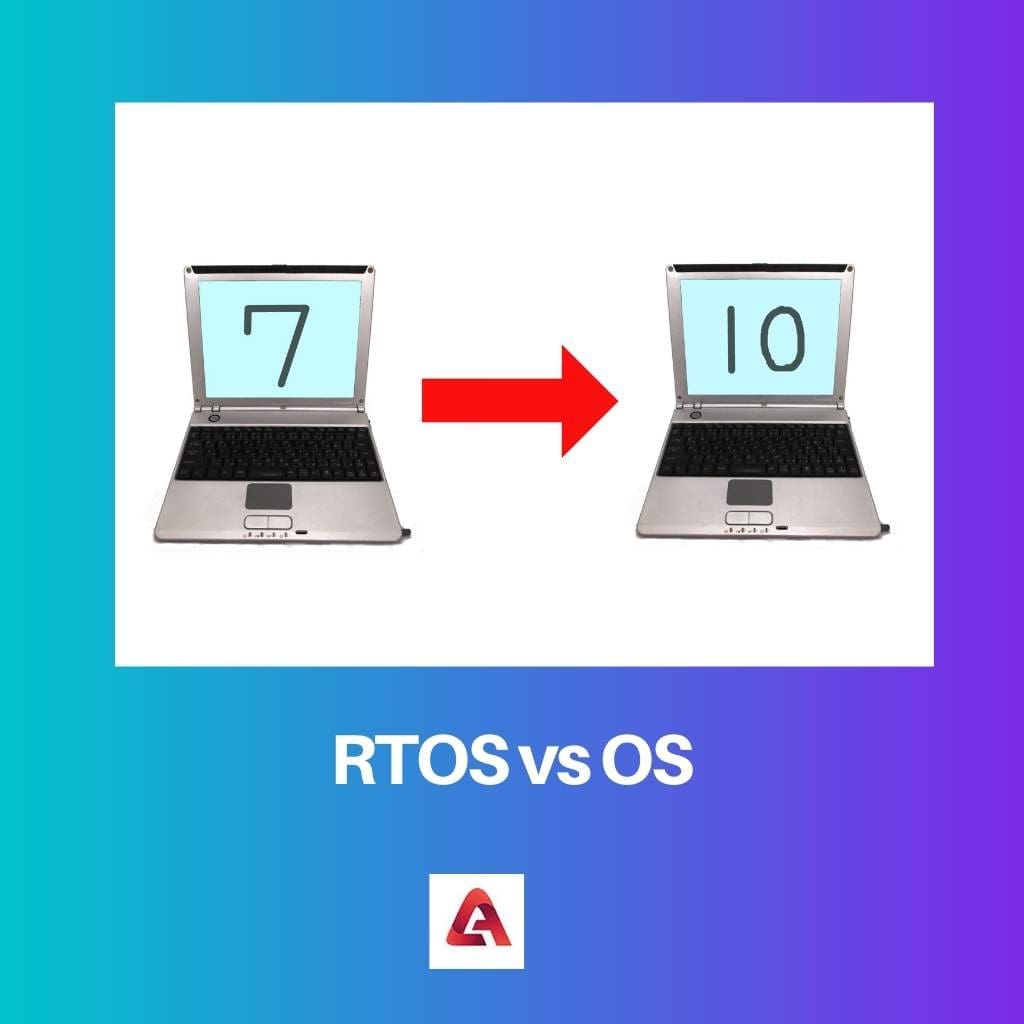The OS, or operating system, which everyone has installed on their computers, is something that most of us are acquainted with. Some of the most popular operating systems for laptops and computers are Microsoft’s Windows (XP, Vista, 7,8,10), Apple’s OS X, Chrome OS, and the several Linux versions available from their creators.
Real-time Operating Systems, or RTOS for short, is a term that most people are unfamiliar with, and this article will define both RTOS and OS for easier understanding. This article will help you grasp the differences and features of RTOS and OS with a descriptive table and USPs as well.
Key Takeaways
- Real-Time Operating Systems (RTOS) prioritize time-sensitive tasks and guarantee task completion within specified time constraints, while general-purpose Operating Systems (OS) focus on overall system performance.
- RTOS serves applications in critical industries such as aerospace, medical devices, and automotive systems, while general-purpose OS caters to personal computing and servers.
- RTOS uses deterministic scheduling algorithms to ensure time-critical tasks execute predictably, unlike general-purpose OS that uses non-deterministic algorithms.
RTOS vs OS
A real-time operating system (RTOS) is an operating system used in systems that provides quick solutions to operations. It is an OS used for real-time computing applications that have a time constraint. An operating system is software that controls the computer’s hardware and software resources. It performs basic tasks like file management and handling input and output.

RTOS stands for a real-time operating system, which highlights its first feature: to regulate planning, RTOS can deal with interruptions successfully using priority-based functioning. An RTOS, unlike a broad-sense OS, is required to fulfil computational deadlines, irrespective of how terrible the circumstance may be.
The reliability of an RTOS in regards to the time it takes to receive and execute an application’s job is a critical feature; the variability is referred to as ‘jitter.’ OS, on the other hand, stands for Operating System.
The most essential program that executes on a computer is the operating system of the whole computer. Every device with a CPU and GPU is equipped with one operating system or two.
The OS controls the storage and operations of the system, as well as all of its firmware, including user interface orientations, software, and even hardware feedback. It also facilitates communication with the computer even if you don’t understand its core coded language.
Comparison Table
| Parameters of Comparison | RTOS | OS |
|---|---|---|
| Full Form | Real Time Operating System | Operating System |
| Definition | As it stands for Real-Time Operating System, this operating system offers quick and precise solutions to prioritized operations. | OS or an operating system is a software application that serves as a conduit between the hardware of a computer and the operator |
| Features | An RTOS can deal with interruptions successfully using priority based functioning | The operating system (OS) on your laptop or pc or even phone controls all of the applications and technology that revolves around your hardware and software |
| Codes | Coding for RTOS is complex and feedback specific. | Coding for a standard OS is easy and hassle-free. |
| Performance and Stability | Although real-time operating systems may give greater efficiency in some instances due to reduced concurrency between services and programs, this is not the case in other situations. | Performance is decent and depends partially on the processor and RAM used in the computer. |
What is RTOS?
RTOS is implemented in situations where a high series of activities, many of which are extrinsic to the computing device, must be accepted and taken immediately or under tight deadlines. As it stands for Real-Time Operating System, this operating system offers quick and precise solutions to prioritized operations.
An RTOS must be capable of parallel processing, proactive, and offer thread precedence, to name a few traits. An RTOS must also have a priority inheritance system (PIS), thread synchronization that is predictable, and a method to prevent priority inversion.
Airline control systems, Central Command Structures, Defense feedback systems, Peacemakers, security detection mechanisms, and other real-time supervision and executable situations require vast usage of RTOS. RTOS is utilized in more specialized applications where reaction time seems to be more essential than the capacity to execute a large number of iterations in a brief period.
Computers that scan levels and statuses in a building are an example. The sensors must notice changes as soon as they happen.
RTOS is a precise and punctual OS that can execute quick operations without taking much time to load. The changeover procedure is so quick in RTOS that it seems to users as real-time.
Some RTOS utilize this architecture as well, albeit with a considerably lower task density, to guarantee that the CPU is never overloaded, which might slow reaction times.

What is OS?
OS stands for Operating System, and it is an essential part of a computer’s interface. OS, or an operating system, is a software application that serves as a conduit between the hardware of a computer and the operator.
To execute other applications, every system software must have at least one bootloader coupled with an OS. Web browsers, MS Exchange, Notepad, executable files, and other applications require a certain environment in order to run and fulfil their functions.
The operating system (OS) on your laptop, PC, or even phone controls all of the applications and technology that revolve around your hardware and software. Several computer programs are operating simultaneously, and they all obtain access to your computer’s central processing unit (CPU), storage, and disk.
All of this is coordinated by the operating system to ensure that each software receives the resources it requires. Any computer you buy will come with an operating system pre-installed.
Although the majority of users stick with the default operating system that came with their computers, it is feasible to update or even switch operating systems. Some examples of OS include Microsoft Windows, macOS, and Chrome OS.

Main Differences Between RTOS and OS
- RTOS stands for Real-Time Operating System, whereas OS stands for Operating System.
- A real-time operating system (RTOS) specializes in extremely quick reaction times, whereas a traditional operating system (OS) concentrates on sequentially computing throughout the whole array of processes.
- RTOS is user and command-specific, whereas an OS is used by everyone for daily processes.
- An RTOS uses a sophisticated scheduling algorithm, whereas a regular OS uses a standard approach to solve tasks sequentially.
- Some examples of RTOS include Vx Works, QNX, RTLinux, etc., whereas examples of OS include macOS, Windows, ChromeOS, and Android.

The comprehensive elucidation of the functionalities and applications of both RTOS and OS is truly impressive. This article offers a thorough and informative analysis of these operating systems.
Indeed, this article excels in offering a comprehensive understanding of RTOS and OS, making it an invaluable resource for readers seeking clarity on these topics.
I couldn’t agree more, Kieran Walker. The article’s detailed exploration of the nuances of RTOS and OS enhances the reader’s comprehension and provides valuable insights into these complex systems.
The descriptive explanation of what RTOS and OS are, and how they differ, is incredibly informative. This article succeeds in making a difficult subject understandable for all readers.
I think that the clear and straightforward writing style of this article greatly contributes to making these complex concepts understandable and relatable. Kudos to the author for breaking it down so well!
Absolutely, Frichards! The author does a great job of breaking down the complexities of RTOS and OS in a way that is both comprehensive and accessible.
The real-time processing needs of different systems are clearly articulated in this article, providing significant insight into the importance of RTOS in specific applications. Well done!
Absolutely, Tom Allen! The article effectively communicates the critical role of RTOS in handling time-sensitive operations in various domains, offering readers valuable knowledge on the subject.
This article does an excellent job of breaking down the complex differences between RTOS and OS, providing a clear understanding of these crucial concepts in the world of computing. The detailed comparison table is particularly useful.
I completely agree with you, Dowen. This article really simplifies these complex concepts, making them accessible to a wider audience.
While the article is informative and well-structured, it could benefit from delving deeper into the nuances of coding for RTOS and standard OS. A more in-depth exploration of this aspect would have been beneficial.
I see your point, Bking. A more detailed analysis of the coding complexities of RTOS and standard OS would have added further depth to the article and enriched the reader’s understanding.
The article effectively highlights the critical distinctions between RTOS and OS. The focus on real-time computing applications and the examples provided make it easier for readers to comprehend the practical applications of these operating systems.
I couldn’t agree more, Cameron. The use of real-world examples to illustrate the applications of RTOS and OS brings a level of clarity to these concepts that is truly commendable.